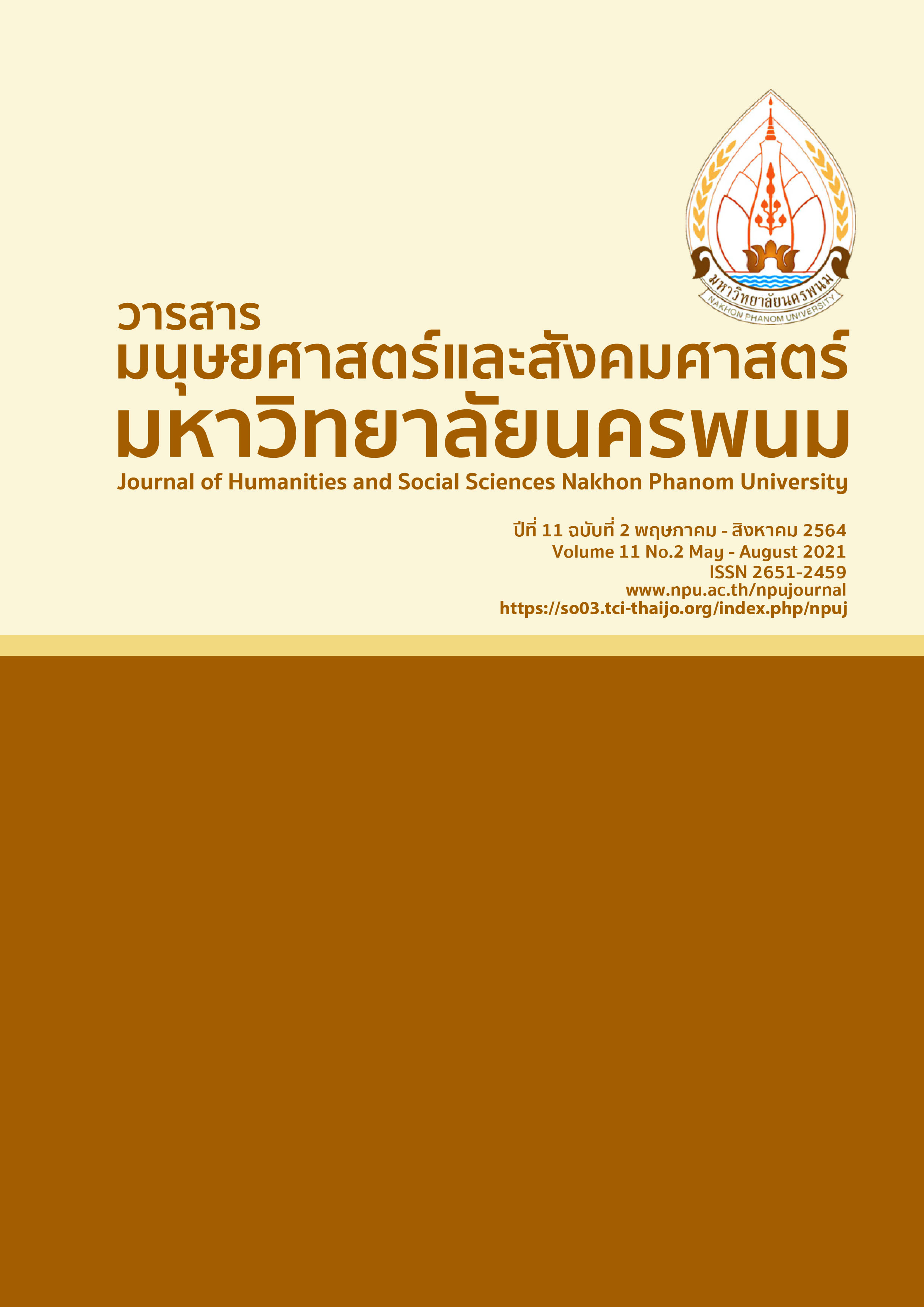Animal Metaphors that Reflect the Concept of Hero and Heroine in Yaoi Novels
Main Article Content
Abstract
The aim of this research was to study the animal metaphor as illustrating upon the concept of the hero and heroine characters 10 Yaoi novels. The main actor refers to male who behaves like female published during the year 2013-2017 through the use of metaphor conceptual analysis. The results revealed that the animal metaphor showing the concept of the hero characteristics had positive meanings, which represent to the ruler, the predator, a man with tall, strong, good looking appearance who attracted the sexuality from both male and female. The characteristics of heroine showed the negative meanings including being under controlled person, victimized, and weaked and untrustworthy characteristics, Regarding the results presented, it revealed the thinking system of the Yaoi novel that Thai society was mostly rely on male-since hero, which was represented by male. Although the heroine referred to male, this character always represented the image of woman who the receiver in the end of the story. Characterizing the heroine as a man who was weak and lacked of authority to request anything from the hero. Such thinking system was considerably binary opposition that has been deeply rooted in Thai society. Although the Yaoi novel is generally recognized as the way to provoke gender equality, the patriarchal system in the society is generally observed in this kind of novel.
Article Details
References
Afterday. (2017). Lang mān. [Behind the Scenes]. Bangkok: EverY.
Bunphan, C. (2004). Khwāmmāi prīapthīap khō̜ng sat nai samnūan Thai .[The Metaphorical meanings to animals in Thai ldioms]. witthayāniphon sinlapa sāttra mahābandit . mahāwitthayālai Thammasāt .
Bunsom, P. (2013). Uppalak nai ʻAngkrit kīeokap sat .[Animal terms as conceptual metaphor in English idioms]. witthayāniphon sinlapa sāttra mahābandit . Mahāwitthayālai Sinlapākō̜n
Chanthao, R. (2017). Uppalak phūchāi læ phūying nai suphāsit bāo sāo Lāo. [Metaphors of Men and Women in Bao-Sao Lao Proverbs]. Journal of Language, Religion and Culture. 7(1),154-183.
Chiffon_cake. (2017). Banlang paksā. [Bird Throne ] .Bangkok: EverY.
Etu De. (2016). Lut lōk thangthī rīak phīwā ( nāi ) thān! [Call me My Lord]. Bangkok: MeeDee.
Honey. (2017). Phanǣk wun chūan khun rkakan. [My office]. Bangkok: EverY.
huskyhund. (2017). Nư̄a mek lem nưng [Cloud No1]. Bangkok: EverY.
Kinsella, S. (1998a). Japanese Subculture in the 1990s: Otaku and the Amateur Manga Movement. Journal of Japanese Studies, 24(2),289-316.
Lakoff G. and Johnson M. (1980). Metaphors We Live by. The University of Chicago Press.
Lertwichayaroj, N. (2017). Hūačhai/wāi. [Yuri/Yaoi]. Bangkok: banbooks.
Mackinnon, C. (1997). In Harm's Way: The Pornography Civil Rights Hearings. Cambridge, MA: Harvard University Press.
May-Twin. (2016). Čham waiwā rak kan. [Memory] Bangkok: Bakery book.
McLelland, M. (2000). No climax, no point, no meaning Japanese women’s boy-love sites on the internet. Journal of Communication Inquiry. 24(3),14.
Min-ur. (2016). Ngao khǣn salak rak [love shadow]. Bangkok: Fireworks Publishing.
NIRIN. (2017). Khitmāk [think]. Bangkok: EverY.
Panpothong, N. (2014). Wāt kam wikhro̜ chœ̄ng wiphāk tām nǣo phāsāsāt : nǣokhit læ kānnam māsưksā wāt kam nai phāsā Thai. [Discourse Analysis linguistics]. Bangkok: Faculty of Art, Chulalongkorn University.
Peecharoen, P. (2013). Khwāmchō̜p dūai kotmāi khō̜ng nangsư̄ kātūn Yīpun praphēt chāi rak chāi čhāk mummō̜ng niti sētthasāt. [Legitimacy of Yaoi Manga in law and economic aspect]. Master Dissertation, Graduate School, Thammasat University, Bangkok, Thailand.
Peeranawong, S. and Srijampha, S. (2019). Kānsưksā prīapthīap kānchai ʻu plak sat thī sadǣng manōthat kīeokap khonnai Thai læ ʻAngkrit. [A Comparative Study of Animal Metaphors that Reflect the Concept of People in Thai and English idioms]. Humanities and Social Sciences Review, Faculty of Humanities and Social Sciences, Lampang Rajabhat University, 7(1),85-105.
Phakdeephasook, S. (2018). Khwāmsamphan rawāng phāsā kap ʻattalak læ nǣothāng kānnam māsưksā phāsā Thai. [Discourse Analysis in Thai]. Bangkok: Faculty of Art, Chulalongkorn University.
Prasannam, N. (2019). Yū kap fǣn : tūa bot yā yō ʻi khō̜ng Thai kap watthanatham mūanchon nai bō̜ribot khām sư̄. [Thai yaoi texts consumed in mass culture and trans-media condition]. Proceeding of The 12th Humanities Research Forum in Thailand , 572-605.
Sae-chia, T. (2016). Phom kō̜ khǣ čhap phī tham mīa khrap ! : čhintanākān rư̄ang kān thāthāi ʻamnāt kap kān (mai) thāthāi ʻamnāt phāitai čhintanākān nai niyāi wāi rư̄ang : phī wāk tūa rāi kap nāi pī nưng. [[just make you my wife, bro]. Imagination of Power Challenge and Unchallenged Power under Imagination in Y Novel ‘SOTUS’]. Proceeding of The 3rd Kamphaeng Phet Rajabhat University National Conference, 131-139.
Satchaphan, R. (2017). Ān wannakam. Gen Z [Reading Gen Z]. Bangkok: Saengdao.
Vespada, D. (2017). Čhūp, plư̄ai , khwāmrak nai lakhō̜n nǣo numnō̜i rak kan . lao rư̄ang rư̄ang lao , [Tell-tales : essays in honor of Soranat Tailanga]. Bangkok: Faculty of Humanities, Kasetsart University, 269-279.
WIND. (2016). Hydrangea. Bangkok: Fireworks Publishing.
Zanghellini, A. (2009). Underage sex and romance in Japanese homoerotic manga and anime. Sage journals. 18(2),159–177.


